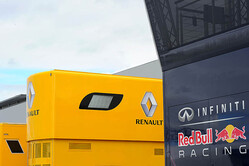


17/06/2015
NEWS STORY
 Remi Taffin, Director of Operations: Austria is the second in a trio of fast, flowing tracks, coming after Montreal and before Silverstone. A high percentage of the lap is taken at wide open throttle with the long straights linked by heavy braking points. These elements, plus the high altitude, make the track very challenging for the Power Units.
Remi Taffin, Director of Operations: Austria is the second in a trio of fast, flowing tracks, coming after Montreal and before Silverstone. A high percentage of the lap is taken at wide open throttle with the long straights linked by heavy braking points. These elements, plus the high altitude, make the track very challenging for the Power Units.
Thanks to the upgrades implemented since the start of the season, we know that the Energy F1 is now robust enough to deal with the challenges of such a track. We have also had a stern test at the last race in Canada pass without any issues. We do acknowledge, however, that we need to concentrate on extracting the most of the performance potential. This is obviously a more long term goal, and we are making good progress in a number of areas.
We know that this track will not play to our strengths, but we need to work with our partners to get the most from the package we have, both chassis and engine, and be ready to take advantage of opportunities.
Fuel consumption will not be a major concern here due to the short lap and quick lap time. The few corners also mean that the engine will not frequently accelerate and brake over the lap, which greatly increases consumption.
The average speed for the race is around 210kph, which is comparable to the previous race in Montreal. The lap time is the shortest of the season, taking a little over 1min 8secs in qualifying trim.
ICE
The circuit consists of four long straights, meaning the ICE runs at full throttle for over 60% of the lap. This figure is comparable with Spa and Monza.
The longest straight is the 800m drag from Turn 1 through to Turn 2. The circuit falls slightly downhill from the first corner before climbing back up. The fluids in the internals of the ICE will be ‘squashed’ when the car drops and then unloaded when the car crests the hill.
The straight from Turn 2 to Turn 3 sees the circuit descend once again. With the car carrying extra momentum, speeds peak at over 320kph just before the braking point to Turn 3.
Turbocharger
Correct drive and response on the exits of the corners is critical since five of the nine corners are followed by a long straight. Any hesitation from the turbo will compromise acceleration and, ultimately, lap time.
One of the main challenges of Austria is the high altitude. The circuit is around 700m above sea level, and oxygen content will be around 7% less. The turbo will therefore have to spin at a much higher rate to produce the same amount of power to compensate for the low ambient pressure.
For the majority of the lap the turbo will be spinning at close to 100,000rpm, or 1,700 times per second.
MGU-K
There are really only seven corners at the Red Bull Ring, which will not give the MGU-K many opportunities to recover significant energy under braking. However teams will need the MGU-K to feed the ICE with extra power down the straights, so making efficient use of the little energy recovered will be extremely important.
The hardest braking spot on the circuit is Turn 2. The drivers will approach the blind entry in excess of 300kph and brake down to second gear and around 65kph. The circuit drops away after the apex so the driver is immediately on the throttle to maximise the acceleration onto the straight.
The other big stops on the lap are Turn 1, 3 and 9. Each of the corners is taken at an average of 120kph and either third or fourth gear.
MGU-H
The long straights mean the MGU-H has plenty of opportunity to recover energy to store in the battery. With a lap time of around 70secs, 46secs (or 65% of the lap) is spent at full throttle.
The flowing complex at the back of the circuit from Turns 4 to 7 is taken at an average of 200kph and between fourth and sixth gear. The driver feeds in the throttle to keep the momentum going and roll into the corners. This generates a steady stream of exhaust, which the MGU-H will recover to feed back to the battery or ICE directly.